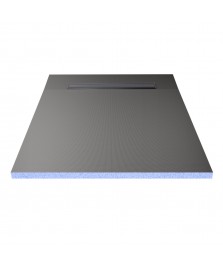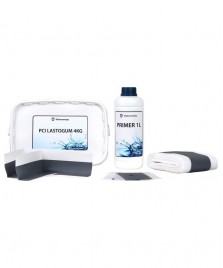- today
- label Wet Room Kits
- favorite 0 likes
- remove_red_eye 3804 views

Creating a sensory bathroom or wet room can be a transformative experience for individuals with various needs. At Wetroomstop, we understand the importance of designing bathrooms that cater to diverse requirements.
This practical guide will explain how you can create a sensory wet room that’s calming, therapeutic, and enjoyable.
What Is a Sensory Wet Room?
A sensory wet room is a specially designed space that combines the accessibility of a wet room with sensory-stimulating elements. Its open, level-access design provides the perfect canvas for incorporating sensory features.
These adaptable environments are particularly beneficial for people with autism, dementia, or emotional and behavioural difficulties. They help reduce anxiety and provide a safe and tranquil bathing experience.
How Sensory Bathrooms Can Help Users
These specialised wet rooms offer endless benefits for users, including:
-
Reducing anxiety and stress during bath time
-
Stimulating and balancing the sensory system
-
Increasing independence and control for users
-
Enhancing safety with specialist equipment and non-slip surfaces
-
Providing opportunities for learning and development. For example, colour recognition and cause-and-effect understanding
-
Improving sleep quality as a result of being calm and relaxed
Key Elements of a Sensory Wet Room
The key elements of a sensory wet room include:
1. Lighting
Sensory mood lighting has been explored in various studies. When used correctly, researchers unanimously agree that light can positively influence people's mood. Various colours of light can enhance the shower experience. For instance:
-
Blue: Promotes relaxation and calmness
-
Green: Encourages balance and harmony
-
Red: Stimulates energy and warmth
-
Yellow: Enhances focus and alertness
2. Visual Elements
Visual stimulation is crucial in a sensory bathroom. Some options include:
-
A sensory projector that provides relaxing imagery or sensory images on walls or ceilings
-
Fibre optic lights that create a mesmerising visual effect and are safe to touch
-
Interactive bubble tubes that are engaging and offer visual and tactile stimulation
3. Sound
Soft music can create a soothing atmosphere. Integrating sensory audio products, such as waterproof speakers and amplifiers, can help users relax. Music can be a great way to reduce tension and anxiety for those who find bath time extremely stressful.
4. Texture
Incorporating various textures in your sensory room can stimulate the tactile senses. The following are great additions to any sensory bathroom:
-
Textured tiles
-
Soft bath mats
-
Tactile wall panels
-
Textured grab bars or handrails
-
Shower curtains or screens with varied textures
5. Temperature Control
Sensory wet rooms should have adjustable temperature controls for water and room temperature. This allows users to create a comfortable environment tailored to their preferences.
6. Specialist Elements and Equipment
To create a safe and accessible wet room, consider incorporating:
-
A height-adjustable basin and toilet
-
A shower seat or bench
-
Grab bars and handrails
-
Non-slip flooring
-
A hoist system for easy transfers
How to Create Your Sensory Wet Room
Designing your wet room involves the following steps:
1. Assess the User's Needs
Consult with occupational therapists or other healthcare professionals to determine specific requirements. This step ensures the bathroom design addresses individual preferences and challenges to maximise its therapeutic benefits.
2. Plan the Layout
Create a spacious, open layout that allows for easy movement. Level-access shower areas with ample turning space are vital for people with wheelchairs, walkers, or other mobility aids.
3. Choose Appropriate Sensory Bath Elements
Select a combination of lighting, sound, and tactile features that best suit the user's needs. Ensure these elements are waterproof and safe for use in a wet room environment.
4. Incorporate Adaptable Features
Use height-adjustable elements to accommodate changing needs over time. This flexibility can also benefit multiple family members.
5. Create a Calming Colour Scheme
Choose soothing colours for walls and tiles. Muted tones like pale blues, greens, or neutrals create a serene atmosphere. Remember, you can still add pops of brighter colours with other elements. For instance, you can use adjustable lighting and removable accessories as needed.
6. Ensure Proper Waterproofing
It’s essential to use high-quality waterproofing materials that are professionally installed. Proper waterproofing is crucial in a wet room to prevent water damage and ensure the longevity of your investment.
Cost-Effective Sensory Bathroom Solutions
Creating an interactive sensory wet room doesn't have to break the bank. Here are some cost-effective ideas to get started:
-
Start with the basics: Begin with colour-changing lights and a waterproof speaker system.
-
Make gradual upgrades: Implement changes over time as your budget allows.
-
Do some DIY: You can create your own tactile wall panels or sensory boards.
-
Explore funding options: Look into grants or funding opportunities for specialist equipment.
Wetroomstop: All the Wet Room Essentials to Engage the Senses
By working with healthcare professionals and using high-quality products, you can create a sensory environment that improves the user’s quality of life.
At Wetroomstop, we offer a range of wet room products to help you create the perfect sensory bathroom. Our all-inclusive waterproofing kits will protect your investment from moisture damage. We have various underfloor heating options to keep your space warm and comfortable. You’ll also find a wide selection of level-access shower trays to enhance safety and prevent falls.
Explore our product range today or contact our friendly team. Our experts can provide personalised advice to help you find the ideal sensory wet room solutions.















